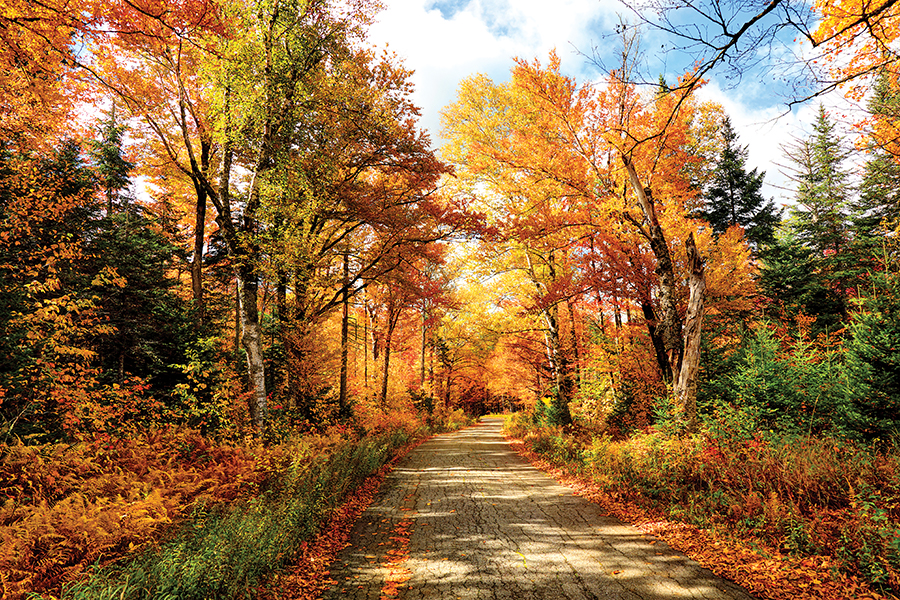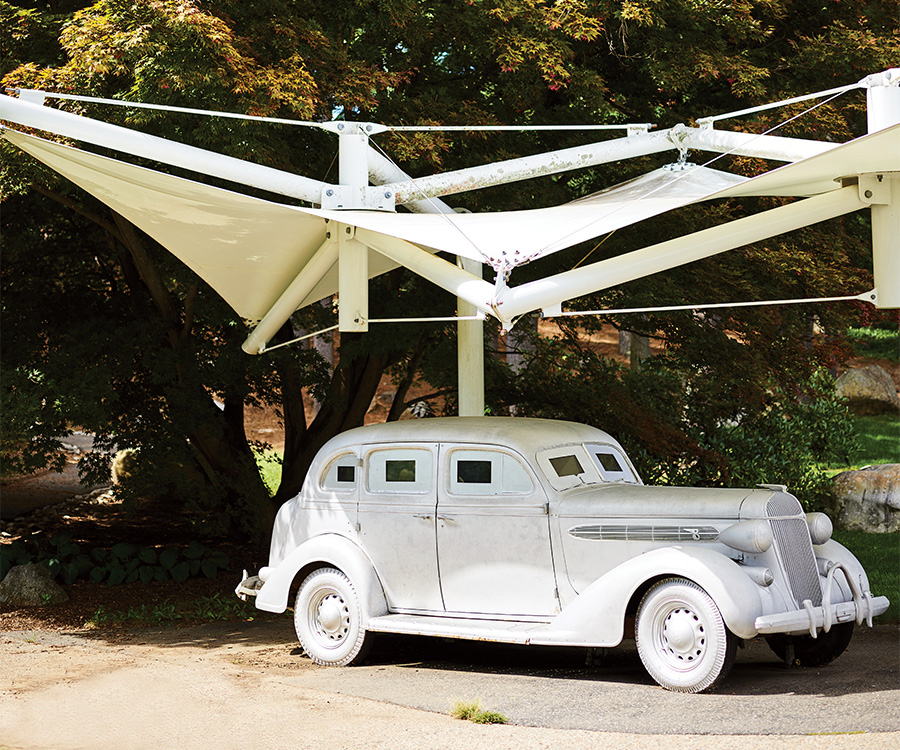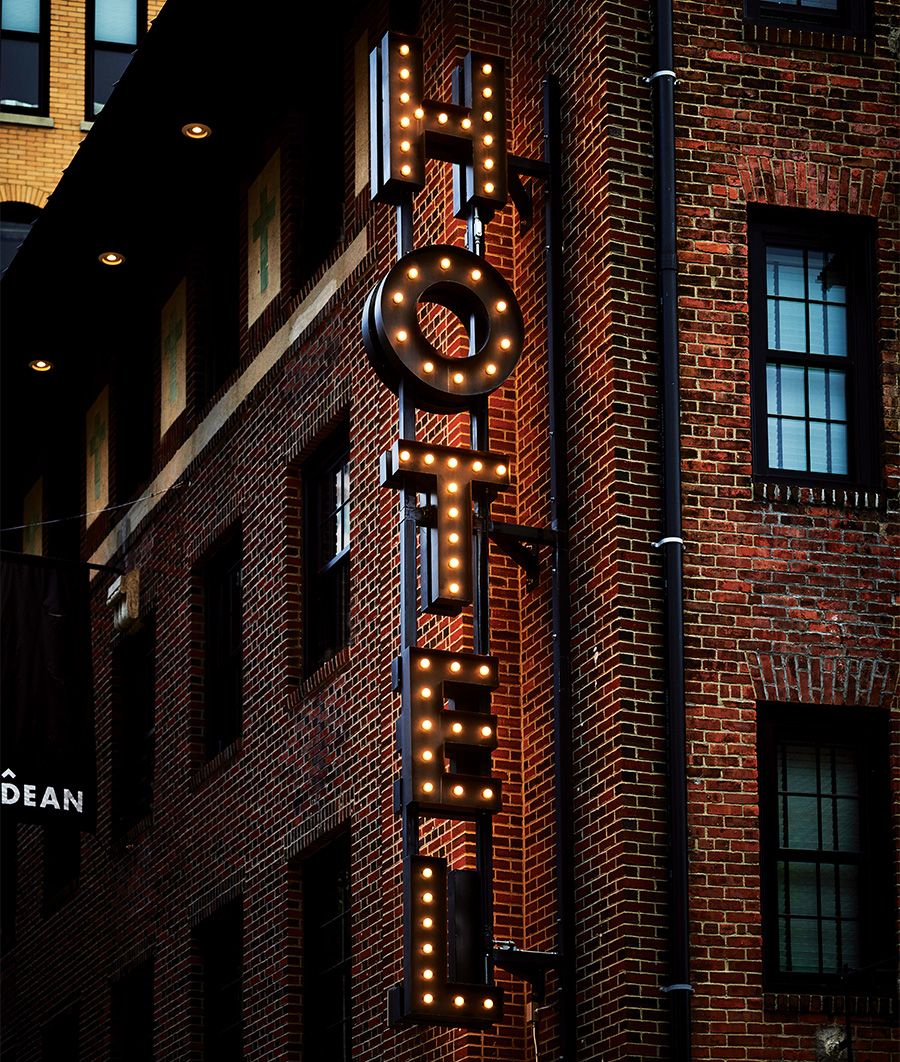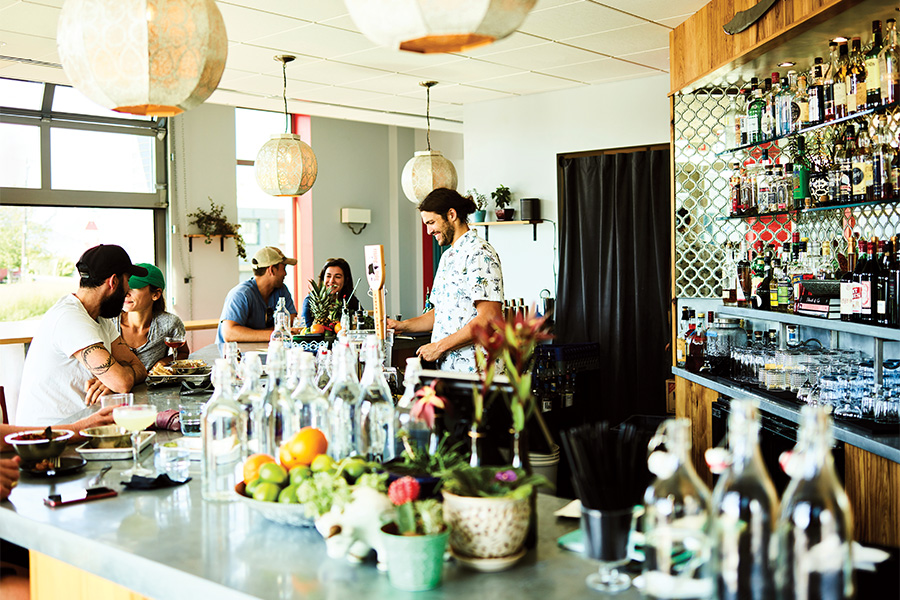Did Somebody Say New England Road Trip?
One adventurer’s search for meaning on a five-day road trip through New England along I-95.

Photo via iStock
It’s just starting to downpour when I pull into the parking lot of Summer Sessions surf shop in Rye, New Hampshire. A beach town several miles off I-95, Rye doesn’t exactly court tourists—it has precisely one inn—preferring instead to remain a place where most everyone knows one another. That’s not to say locals aren’t friendly to outsiders: Rye has some of the best surfing in New England, and a laid-back vibe to match that lasts well into the fall, when the water is almost warm enough to swim in.
After three long days on the road, today is—or was—my designated beach day. My plan was set; earlier that afternoon, I’d ignored the looming clouds and pulled on my swimsuit. I would rent a paddleboard from Summer Sessions and walk it across the street to Rye’s Jenness Beach. Then I’d spend an hour sitting around with an iced coffee from Sandpiper Café reading something mindless, and eventually make my way to the Carriage House for a 7 p.m. date with some oysters and rosé. It was a loose plan, but a plan nonetheless—and one I’d been looking forward to.
It was also a test. Because in New England, of course, weather-dependent plans are never the best-laid. I would not be going paddleboarding today. But road trips are flexible by design, and even better, at least on this particular adventure, I had no one to please but myself.
Before filling up the tank and hitting the highway, I had asked myself: What makes a good road trip, anyway? Fun snacks. A killer playlist. A passenger with good stories and a willingness to help drive. An open road. Scenery.
That’s what convention tells us, anyway, especially here in New England, where autumn wanderlust sends us to our cars in pursuit of charming seaside villages and lots of leaves to peep. But while the idea of meandering your way down through the farmlands and waterfronts of Route 1A in Massachusetts or up New Hampshire’s mountainous Kancamagus Highway may seem romantic, sometimes we just want to get where we’re going, and get our long weekend started already. And sometimes, too, we just want to be alone.
That’s where I found myself recently with a few open days in my schedule and an uncontrollable urge to get in the car and drive. My husband wasn’t free to play hooky with me, and actually, I was okay with that. I’d lately been making an effort to spend more time by myself. Science says it’s good for you: Benefits include better concentration and productivity, lower stress levels, and fewer dumb arguments with your partner, or so I’d been told, all of which may help explain why, according to Pinterest, searches for “solo travel” are up 600 percent since last year. I grew up an only child, so I know how to entertain myself—at least I did at one point.
At the same time, just because I wanted to travel alone didn’t mean I wanted to spend all day and night alone in the car. This is how I convinced myself that my ultimate New England road trip would take place almost entirely along I-95—one of the most dreaded and least scenic roadways we’ve got. It’s not quaint, there are no harbor views or rolling hills, and everyone is too angry (or too glued to their phones) to enjoy the foliage. But it gets you from Connecticut to Maine—five states!—in less than 200 miles, and there’s more for drivers to do than first meets the eye at 65 miles per hour, in some surprisingly beautiful places. As I’d inched my way through life into my forties, I’d been working on shifting my perspective—letting go of preconceived notions, being more flexible, all of that praiseworthy stuff—and this seemed as good a test of that as any. Could even the most well-traveled path be not just bearable, but enjoyable, and even full of purpose? Over several days, armed with nothing but an iPhone, an L.L. Bean tote, and a trusty Prius, I decided to answer that question.
Day 1: Mystic, Connecticut,
To Westerly, Rhode Island
9 miles
I officially begin my road trip in Mystic, an undeniably quaint village that spans the two Connecticut towns of Stonington and Groton, just south of the Rhode Island border. There are cobblestone streets, a seaport filled with historical ships, and an aquarium with really cute sea lions. But the overall feel is far more modern than I remember from the last time I was here, in the early aughts—this is not your grandmother’s seaside town anymore. There’s Spicer Mansion, a former ship captain’s summer home turned Relais & Châteaux property with a private collection of maritime art and antiques that could fill a museum, and Rise, a tiny brunch spot with counter seating and a bacon, egg, and peanut-butter sandwich the gentleman sitting next to me describes as the reason “they make Zantac.” (It’s actually delightful, if maybe a little unmotivating.)
Which is fine, because this particular Monday isn’t shaping up to be especially stressful: Although plenty of people live here year round (about 4,200), Mystic is the sort of place that exudes vacation. The village downtown is compact, with a walkable main street offering all the usual charms: an excellent wine and craft liquor shop, Universal Package Store, where I pick up a small-batch whiskey for a friend; quirky boutiques Mystical Toys and Trove, where I find the Scratch & Sniff Book of Weed (also for a friend! honestly); and a very good independent bookstore, Bank Square Books. I stop in for a quick peek at the Mystic Museum of Art, which has a small but impressive permanent collection of 250-plus works from American artists and runs a regular paint-and-party night called “Liquid Canvas” that a docent tells me is especially popular with “the young people.” She says that what residents really love about Mystic now, though, is its restaurant scene, and directs me to two in particular: Grass & Bone, a hybrid butcher shop/counter-service restaurant, and M/Bar, which used to be a 1950s gas station and auto-body shop called Frank’s; now they fix small plates and craft cocktails. But I don’t have time to stay for dinner—I’m on a mission to get back on the road and make it to the seaside town of Westerly, Rhode Island, to catch the sunset.

A road-trip-friendly scene from Lincoln’s deCordova sculpture park. / Photo by Christopher Churchill
The truth is, I’ve just slept with the enemy, so to speak: Although Connecticut’s and Rhode Island’s histories are similar—both were founded by preachers during the 1630s, both were early players in the Industrial Revolution—the two states actually sort of hate each other. Rhode Islanders generally regard Nutmeggers as haughty, and they in return see Rhode Island as pointless. “I know it sounds harsh,” argued the late writer Donald Dale Jackson in the Smithsonian in 2000, “but Rhode Island is too small to be a state, and it occupies space nature intended to be part of Connecticut.”
Rivalries aside, the first thing I notice when I walk into Westerly’s Olympia Tea Room—an ornately chandeliered, dark-wood space at odds with its beachy location—is the giant oil painting of a cat holding a black bass that’s hanging over the bar. It’s one of several quirky pieces by Marcia Felber, who’s owned the Tea Room, in the town’s tony Watch Hill section, with her husband, Jack, since 1980; before that, it had served as a soda shop since 1916. The food is fine, but the real reason people come here is to watch the setting sun, which blazes over the wooden sailboats and motor yachts nestled into the Watch Hill Docks across the street before dropping into Little Narragansett Bay. Sarah Cooper, the innkeeper at the Margin Street Inn, where I’m spending the night, had warned me that Monday nights are quiet in Westerly, but it’s shoulder to shoulder at the Tea Room bar and, says Devan, the bartender who makes my negroni, reliably so. “You’d think the sun didn’t set every night,” she says.
Unlike, say, New York City, where everyone’s from somewhere else, pretty much everyone in Rhode Island grew up in Rhode Island, or summered or schooled there, or had a cousin who did. For Rhode Islanders, six degrees of separation is often more like two or three. A native myself, I test out the theory on Tom, the guy seated next to me at the bar: It takes exactly 30 seconds to figure out who we have in common (his brother’s best friend married my favorite childhood babysitter). Most native Rhode Islanders don’t leave Rhode Island unless they have to, at which point they spend their lives figuring out how to get back. The Felbers—Marcia went to Bryant University—run the Tea Room with their daughter, Georgia, who works as the sommelier and also runs a boutique next door called WH20. The Margin Street Inn, meanwhile—a bed-and-breakfast that opened in spring—is owned by mutual fund investor Charles Royce, who went to school at Brown. And here I am, whiling away the evening alone at a bar in Westerly, not far from where I grew up but seemingly a world away.
Day 2: Westerly, Rhode Island, to Providence,
Rhode Island (Pit stop in North Kingstown)
50 miles
To be clear: A road trip on 95 doesn’t have to mean McDonald’s at overcrowded rest stops every few hours until your jeans pop. Even road warriors can stick to their wellness routine—and maybe even find a little peace—along the highway. This is on my mind Tuesday morning, as I veer off 95 in search of a morning pick-me-up, bleary-eyed from one too many negronis the night before. My destination? Rhode Island Power Yoga, a heated studio in a North Kingstown shopping plaza, conveniently located next to a Starbucks. Just like 95 itself, there are no frills or pretense here, just a guaranteed way to get you where you want to go. An hourlong class in a room coincidentally warmed to 95 degrees leaves me detoxed and ready to face whatever traffic nightmare may unfold en route to Providence, where I’m eager to check out how the desolate downtown I remember from my childhood has been transformed into a trendy shopping and eating destination.
A half-hour and two bottles of cold water later, I’m strolling into the museum at the Rhode Island School of Design, where a show exploring various notions of “freedom” features paintings, sculpture, prints, and photos by artists such as Robert Mangold and Walead Beshty. The theme feels fitting for my trip on the open road, and I spend the afternoon wandering around, soaking in more than 100,000 works spread across five buildings, including pieces by Degas and Monet. Standing there alone, I realize that I’ve always enjoyed museums far more on my own than with a companion, anyway.

The Dean, a former strip club turned boutique hotel in Providence / Photo by Christopher Churchill
Afterward, I check into my room at the Dean, a former strip club turned 52-room boutique hotel. Rooms are very affordable and small, though the hotel wasn’t exactly built for sleeping, anyway: It houses the city’s only karaoke bar and a wildly popular in-house Asian-fusion restaurant, North, where I find a mix of proper-looking professor types, blue-haired twentysomethings, and your average semi-suburbanites gathered at communal tables. I have no one to sing with and no one to drink with, which is fine with me— I’m more than happy to retire to my room for an early night after a dinner of charred bok choy and dan dan noodles with local squid. Tomorrow, after all, will be my longest haul yet.
Day 3: Providence, Rhode Island,
To Rye, New Hampshire (Massachusetts Pit stops in Lincoln and Newburyport)
126 miles
Some days you want to drive a little and stop a lot along the way, and some days you want to make tracks; 95 is great for both. But this morning, I’m just trying to lower my blood pressure after a particularly trying few hours on the road (who knew that driving north out of Providence at 8 a.m. would drop you in standstill traffic?). By exit 28B in Massachusetts, I’ve had enough: Alone and in no rush, I veer off the highway for an unscheduled pit stop at deCordova Sculpture Park and Museum in Lincoln. When it opened in 1950, the deCordova was the only area museum to focus on living New England artists, and it has maintained a commitment to representing local talent, especially emerging and mid-career artists, with a permanent collection of 3,500 works dominated by photography. But the real draw is the museum’s 30-acre sculpture park, which typically contains up to 60 large-scale modern and contemporary works discoverable over a lovely, wooded walk.
I grab a coffee in the museum’s onsite café before hopping back into the car to carry on to Newburyport, under an hour away and one of the North Shore’s most accessible “destination” towns. Unlike most beach towns, Newburyport—which with about 18,000 residents is actually a city—doesn’t shut down when the weather cools off, and there’s still plenty to do after the summer crowds diminish. Your GPS won’t tell you that exiting I-95 at 56 is a prettier option than the more-traveled exit 57; Scotland Road starts in Newbury and weaves past farm stands selling fresh corn and sunflowers, and eventually leads to Newburyport’s dueling breweries: the new RiverWalk Brewing Co., whose taproom regularly hosts Saturday-morning yoga, and the Newburyport Brewing Company, which offers live music Thursday through Sunday. Newburyport is a place where even locals will line up for good food, particularly carbs—see the throngs patiently snaking around the block in pursuit of doughnuts from the Angry Donut or bagels from Abraham’s, both well worth the wait.
Today, though, I’m just here for an avocado toast and iced tea at Joppa Fine Foods before making my way to Rye Beach, where I have an afternoon date with a paddleboard and a room reserved at the trendy Hotel Portsmouth nearby.
With thunderheads on the horizon, though…well, you know how that adventure turned out.
Day 4: Rye, New Hampshire,
To Scarborough, Maine (Pit stop in Old Orchard Beach)
54 miles
The clouds that thwarted my paddleboarding excursion in Rye are long gone the following day when I reach Old Orchard Beach in Maine, an unabashedly showy town less than 10 minutes from 95 that feels a little like a New England never-neverland—a place where motels announce vacancies in flashing neon, most meals are handheld and eaten while bar-hopping, and any hint of New England pretense goes out the window.
Old Orchard Beach— “OOB” to those most familiar—is most definitely not a “no shirt, no shoes, no service” sort of town. Men and women wear muscle tees and cut-off denim with abandon; kids roam in large packs, collectively giddy in light of the general lack of supervision; and the Palace Playland Ferris wheel always looms large in the background. The souvenir shops selling sweatshirts and bachelor-party-ready gear (see: tanks that read “Drunk 1” and “Drunk 2” in the style of Dr. Seuss characters) also deal in single cans of beer and the plastic cups that pedestrians need in order to circumvent open-container laws, which is why every third person you see strolling the boardwalk clutches a red Solo. It’s the sort of behavior that was fun in college and, I think as I crouch behind a dumpster to empty my can of Bud Light into a cup, is still pretty fun now. And yet at a time when it seems like gentrification has left no beach town untouched and “luxury” is the buzzword in travel, places like Old Orchard Beach—and its kin, such as Hampton Beach in New Hampshire and Salisbury, Massachusetts—get overlooked, if not totally dismissed. When I tell a staffer at a quaint inn that I’m excited to visit OOB—the first time I’ll have been, despite living most of my life in New England, including four years of college in Maine itself—she gives me an “Eee, really? Why?” and a face that says, “I just ate a bad clam.”
But what I like about OOB, from the very instant I arrive, is how assuredly, and unapologetically, OOB it is. It’s not trying to be anything other than itself. Who among us couldn’t be a little more like that?
I’m spending the night next door in Scarborough, one town and seemingly a million miles away, where shingle siding replaces neon and where you could spend a week deciding which of its beaches takes the prize for most pristine. The 23-room Higgins Beach Inn, by the looks of it staffed entirely by a bunch of twentysomethings on college break, is sandwiched between two of them—Prouts Neck and Crescent Beach—and within walking distance from the Eastern Trail, a woodsy running and biking trail that passes by the now-abandoned Scarborough airport. More than one local tells me how Charles Lindbergh flew into the airport several times. The inn’s 1897-era building was acquired last year by the Maine-based Migis Hotel Group and thoughtfully renovated following a casual surf theme. It feels very New England, with a three-season porch and a restaurant featuring a lobster roll done the Maine way (with mayo)—though I opt instead for a tray full of fried seafood at Ken’s Place, where the bartender recommends the house brew (Bud Light, naturally) and shoves a pile of napkins in front of me. “Here,” she says. “You’ll thank me later.”
Day 5: Scarborough, Maine,
To Portland, Maine
8 miles
“We often get asked, ‘Do you have ghosts?’” says Tony Delois, co-owner of the Francis, a recently opened 15-room hotel in Portland’s West End, as he sidles up to the bar at Bolster, Snow & Co., the lobby-adjacent restaurant. “Unfortunately—or fortunately—we haven’t had any supernatural visitors.” The question makes sense when you consider the 19th-century building’s history: It served for 80 years as a funeral home and had been vacant for more than a decade when native son Tony, who previously worked in hospitality in Manhattan, and his brother, Nate, bought it and turned it into a place for hungry travelers—including me—to rest their weary heads.
I’ve stopped here because the general consensus among tastemakers is that Portland is now New England’s coolest city. Thanks largely to an influx of bigger-city expats who move to town looking for better work/life balance (and more affordable rents), this final stop on my New England road trip may, in fact, feel the least New England—and not in a bad way. This summer, Bon Appétit named Portland its Restaurant City of the Year, calling out Drifters Wife—run by a former Brooklyn couple—Jewish-style deli Rose Foods, Middle Eastern café Baharat, and Vietnamese street-food spot Cong Tu Bot. Locals are just as excited about it as visitors: At a sweaty class at Portland Power Yoga (still trying to keep up my wellness regimen on the road!), a fellow student directs me to Terlingua, her favorite spot along the city’s newest “restaurant row” in the East End neighborhood, for fish tacos and street corn. Meanwhile Rachel, who works at the women’s clothing shop Judith, insists I must not leave town without having a sticky bun from Tandem Coffee + Bakery, “the most Instagrammed place in all of Portland,” she says.

The cheerful counter at Middle Eastern street-food spot Baharat. / Photo by Christopher Churchill
Without a doubt, Portland is a town built around not only eating but also drinking. There are nearly two dozen craft breweries, including Oxbow Blending & Bottling, where Julie recommends a smoky saison-style beer called Bowie; nano-brewery Bissell Brothers; Urban Farm Fermentory, which features 22 rotating taps of kombucha, cider, mead, and beer; and Rising Tide, where the light, bright tasting room feels like the perfect place to kick back with an IPA and reflect on the past five days on the road.
It’s a couple hundred pretty diverse miles between Mystic and Portland. One could spend five hours, five days, or five weeks making the trip, and—even via 95—it’d be different every time. I’ve been speeding up and down this route since I was a kid, and after spending the better part of the week hopping on and off the exits, getting to know the places and faces along the way, I can’t say I’ll ever see it the same again. Which goes to show you: Even the most mundane of paths, on the road and in life, can have meaning if you can find a moment to look at things a little differently—and veer off the highway to explore every once in a while.
•••


